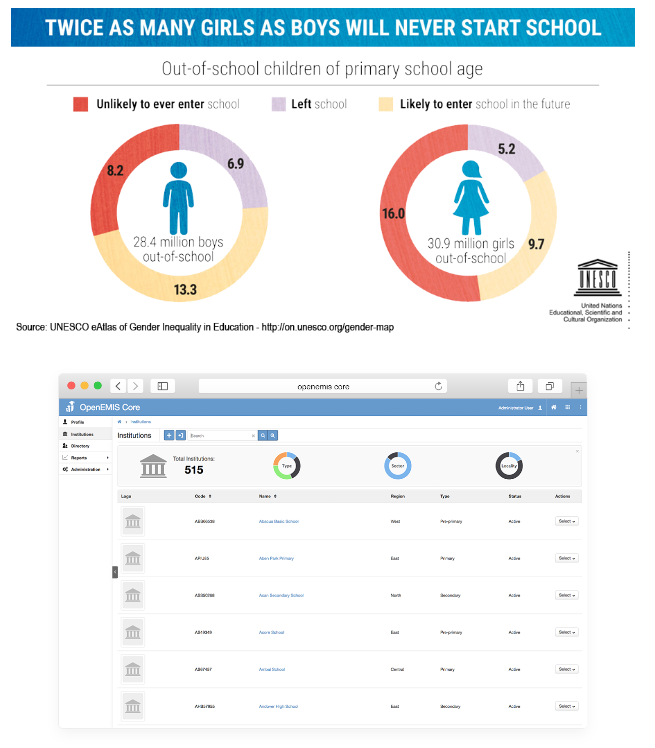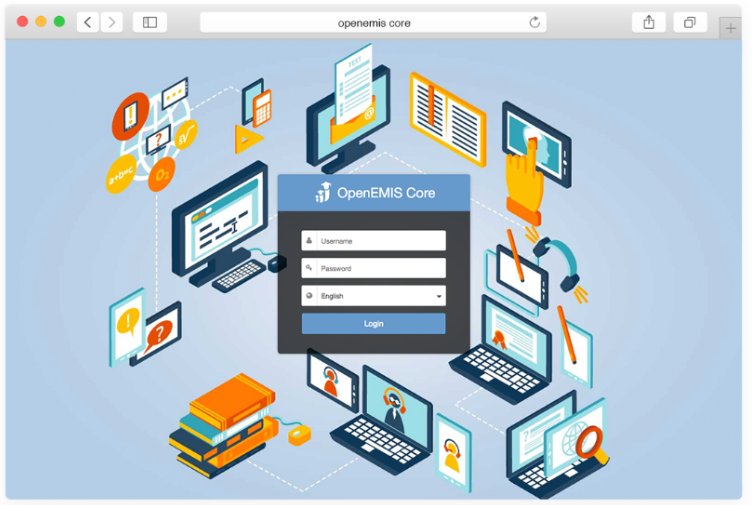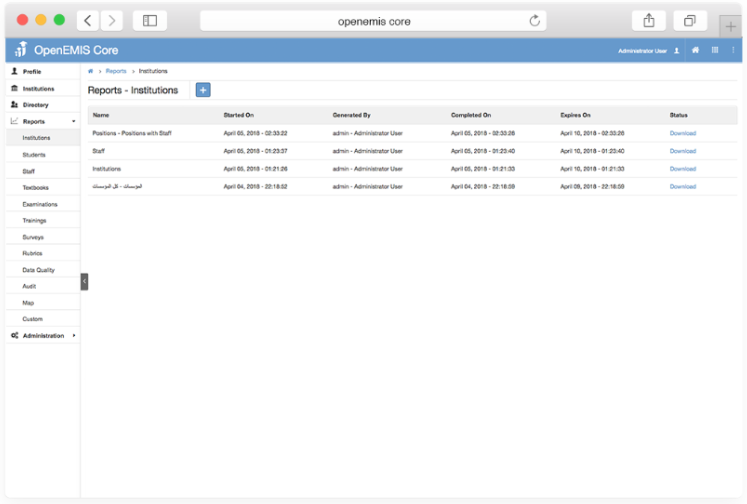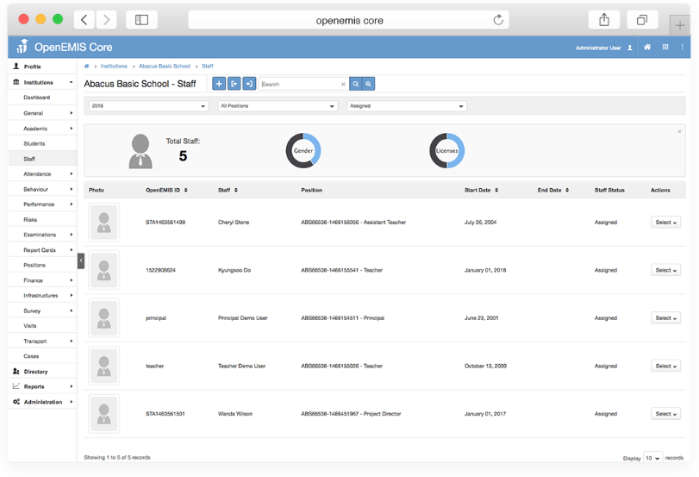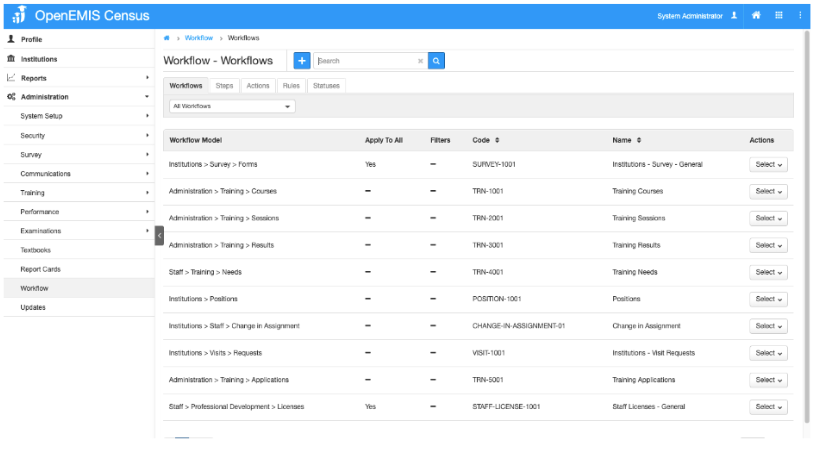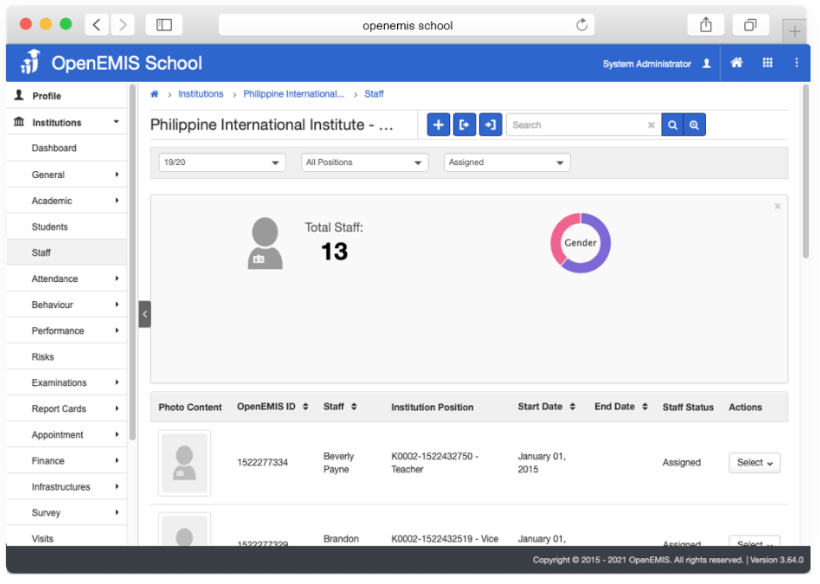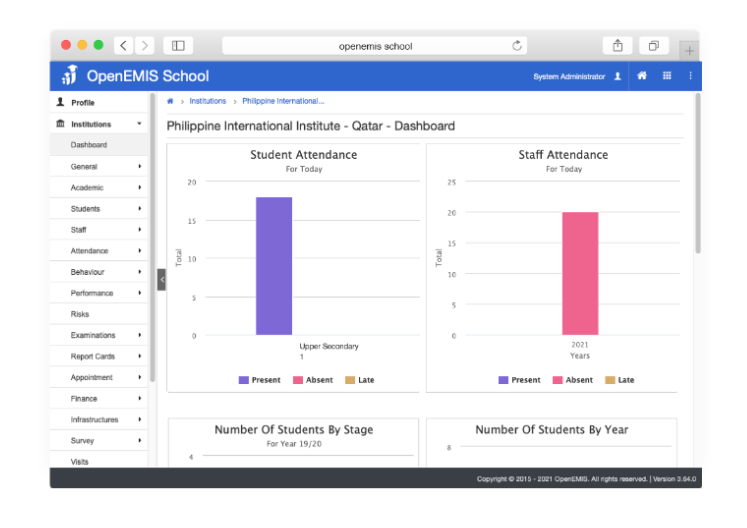UNESCO has teamed up with ValueCoders to design an open-source education management information system. The OpenEMIS initiative aims to deploy a high-quality Educational Management Information System (EMIS) designed to collect and report data on schools, students, teachers, and staff. Working with ValueCoders, the client wanted a royalty-free system that could be easily customized to meet the specific needs of member countries while also being simple enough for less computer literate users to adapt quickly. OpenEMIS is a user-friendly, customizable and accessible software solution available for all member states to customize and independently modify the needs of the education sector.
The objective is to equip all schools, colleges, and universities with an efficient EMIS system tailored for educational purposes.
OpenEMIS Core is a sector-wide Open-Source Education Management Information System (EMIS) that facilitates the collection, processing, and management of education information.
It is a customizable web application that supports the day-to-day activities involved in managing a sector-wide education system. UNICEF uses this project in different countries.
OpenEMIS Dashboard builds, shares, and/or views selective indicator-based data in predefined layouts using tables, graphs, and maps online and offline.
Collaborating with ValueCoders, the client expected an adaptable and non-profit software solution for member state countries to customize the needs of their education sector.
The OpenEMIS initiative aims to deploy a high-quality Education Management Information System (EMIS) designed to collect and report data on schools, students, teachers, and staff. UNESCO conceived the system to be royalty-free that can be easily customized to meet the specific needs of member countries. UNESCO coordinated the initiative with technical support provided by the Community Systems Foundation. OpenEMIS is well positioned to support national system strengthening in the country while addressing the monitoring requirements of Sustainable Development Goals. OpenEMIS is deployed as a cloud-based application and is designed to be mobile responsive, allowing for access to smartphones and tablets and more traditional laptop and desktop computers. A suite of tools is available to enhance OpenEMIS software, providing solutions for data collection, management, analysis and procurement of resources.
OpenEMIS is an easily customizable and non-commercial software solution that member state countries can modify and update the requirements of the education sector autonomously. OpenEMIS Core robust EMIS with data collected from institutions, staff, and students owned and managed by the Ministry of Education. The application allows to capture and track various features of education data such as Early Childhood Development, Disabilities in Schools, Out of School Children, School Meals, Wash in Schools, Education in Emergencies, Technical and Vocational Education and Training, etc.
Users can easily customize the system by configuring the education structure and field options to monitor student data on attendance, achievement, and behavior; staff data by location and level of qualifications; and accommodation of special need students following the national policies. OpenEMIS Integrator, OpenEMIS DataManager, and OpenEMIS Dashboard offer to facilitate information flow between the software and other relevant management tools used for education policy planning. The applications visualize trends with key education performance indicators as well as link education to the other sectors that policymakers can review comprehensive equity in education data in a timely manner.
The system Admin can create multiple users in different schools from the admin panel, such as students, employees, super admin, principal, group administrator, district officer, parents, homeroom teachers, etc. He can also create groups and give permissions (like add/edit/delete/show/hide) to users according to their roles.
1. Super Admin
2. Admin
Problem statement – Creating a feature to generate the issuance of certificates for students. Allowing users to generate duplicate and original certificates.
What we did – We introduced two portals into the system of Issuances and Certificate Templates. From the certificate templates page, we developed the functionality to create generic templates for certificates depending on the selected examination. From the Issuances page, the user will be able to generate certificates.
Problem statement – Integrating multiple databases with different technologies to generate a graphical representation of analytics.
What we did – We develop the feature so that it can establish the connection with different databases and fetch data and create a json of that data, and then that is used to create graphs, maps, etc.
Problem statement – Fixing the old functionalities and also creating new functionality in the project.
What we did – First, we corrected the mistakes in their project and created new functionalities as per the client’s wish.
We did corrections on the database and code level. After removing the redundant code, we wrote the robust code to further increase the reusability of the code. We conducted regular discussions or agile meetings with the client to stay on track. We used normalization techniques to create multiple tables and maintain proper synchronization between the tables. We created a user-friendly view to understand the functionality for the client.
One of the most essential parts of our role at EMIS is documenting the results of our work. This is another area that is often forgotten or overlooked. Simple reports, abstracts, policy papers, mechanisms for feedback information collection, methods of monitoring activities, evaluation reports, technical and training manuals, and hardware and software manuals, etc. all have to be documented.
For effective documentation, ensure that:
A. All records are kept in a safe place and are easily retrievable when needed.
Such records include:
B. A responsible person is assigned to handle records management, and if not full-time, then at least temporarily.
C. There is a clear description of what records there are, and how and where they are kept, so that accessing them is easy.
We effectively achieved the establishment of EMIS system with the realization of the importance of information systems development for all functions of the MoE. We committed ourselves to establishing or strengthening an EMIS system by encouraging EMIS staff and allocating the budget. In addition, an able, dedicated and willing management team at EMIS that can give necessary leadership in the development of an information system within the MoE is also a key requirement.
Further, we fulfilled the requirements of the EMIS management team are that it can coordinate resources and personnel, provide leadership with vision, and explore the environment for high performance by using essential feedback information. Hence, a competent manager is required.
Finally, EMIS management is made capable of taking on board all stakeholders, especially the users, and achieving continuous dialogue about what is required and what can be achieved both in the short- and long-term. Management is also responsible for working with EMIS staff so that they realize the importance of the role users play in the effort of establishing and strengthening an information system within the MoE. Management must also encourage EMIS staff to pool their expertise and work together, learn from one another, and be innovative in the approach to achieving a common goal.
The ability to use the systems thinking approach of looking into the future, working back through the feedback information, assessing the current state, and planning well with a good grasp of the environmental factors considered is indispensable. This applies to all the procedures discussed above and all relevant activities that strengthen EMIS. Having a clear vision is the heart of every system.
Learning from our own successes and failures enhances our own knowledge and provides feedback for effective problem-solving strategies at a higher level. This is usual practice for any learning organization. It allows management and the EMIS team to tackle problems, leading to mastery over the skills needed to achieve the goals.
The role of EMIS is to strengthen the national capacity to provide accurate, timely, and relevant information for policy-makers, planners, decision-makers, and decision support systems. In order to do that, EMIS needs to develop the ability to:
a. Build a sound vision to develop an information system that supports the overall development of the education system.
b. Work and hold a dialogue with users of information and learn from them continuously.
c. Plan the change management effectively, implement the plan and develop the ability to learn during this process for the benefit of all EMIS personnel and the user community. Every year there comes a change. Hence, a yearly assessment of every activity is needed.
The quality of the products we generate will have a far bigger impact than we can anticipate in catching the attention of users and drawing them towards information use. The more information is used, the stronger the demand for it, and, the better the use of quality information, the better will be the decisions made, which will further advance the overall development of education.
